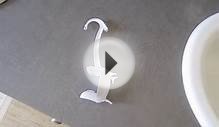
Qualified advice on the best way to repair difficulties with stuck or frozen door hair, tips that don’t work, and latches that don’t latch.
Numerous door knob and lockset issues are corrected before they become therefore severe that the lockset doesn't work at all. Often, a malfunctioning latch system or lock procedure triggers the situation. An improperly operating latch could be the consequence of a poorly fitting home. The lock mechanism cannot work due to the fact the lock is dirty or dry and needs becoming lubricated with graphite (do not use almost any oil since this will gum-up the works).
For severe lock dilemmas, it is almost always best to call a locksmith or even change the lock totally. Many interior door knobs are fairly cost effective to change; it doesn’t really spend to have these professionally repaired unless these are generally special. You can get home knobs online.
Outdoor latches and locksets, however, can be extremely costly. If you'd like an expert to correct problems with a high-quality door knob or lockset, getting rid of the equipment and taking it to a locksmith is usually much less high priced than having the come to you.
Door Latch Is Misaligned
If a door latch cannot run smoothly, the latch bolt on home might not be arranged precisely using the strike plate on doorjamb. Repairs include making minor latch corrections to repositioning the door.
In the event that latch cannot catch, close the doorway slowly to view the way the latch bolt satisfies the attack plate. The bolt could be situated above, below, or to one side of the hit plate. (Scars regarding hit plate will show where it's misaligned.) It is also possible the entranceway has actually shrunk in addition to latch no further reaches the strike dish. Once you have figured out the problem, try one of several techniques shown here.
For under a 1/8-inch misalignment of the latch bolt and hit plate, submit the within sides associated with plate to expand the orifice.
In the event that latch cannot attain the attack dish, shim from plate, or include another hit plate. In the event that latch however will likely not attain, shim out of the door’s hinges. Substitute the entranceway with a wider one as a final resort.
For over a 1/8-inch misalignment, remove the hit dish and extend the mortise higher or lower as needed. Substitute the plate, fill the space at the top or base with lumber putty, and refinish.
Doorknob Is Loose
Doorknobs could become free over time. Methods of tightening them depend upon the sort of lockset. You'll tighten an easy inside mortise lockset such as the one shown at remaining the following:
1) Loosen the setscrew on the knob’s shank.
2) support the knob on the other side of the door, and change the free knob clockwise until it meets snugly. Then tighten up the screw until you feel it resting from the level side of the spindle. The knob should turn freely.
3) If this doesn't help, take away the knob and look the spindle; if spindle is used, it must be replaced. If entire lockset is used, it is best to replace it completely.
Door Lock & Key Issues
Door latches and locks tend to be somewhat complex items of equipment with a few working parts that may go wrong and cause them to be unworkable or balky. For helpful do-it-yourself restoration techniques for fixing common lock and latch problems, please see How to fix Door Locks.
Door Secret does not Work
If for example the door secret does not work right, the initial and most apparent action will be certain you’re using the right secret. When you get the door open, take to the important thing again. If it works quickly, the deadbolt is not engaging the hit plate correctly. If it cann’t work any much easier, lubricate the lock with graphite. Then spray somewhat graphite on the secret and attempt it several times.
In the event that key turns but does not unlock the lock, disassemble the lock to enable you to be certain the cam or tang is precisely engaged with all the bolt. Replace any broken parts and reassemble the lock.
Could be the lock frozen? If key won’t go in to the lock, ask yourself if weather is cool enough for the lock to-be frozen. In case it is, you can warm the important thing and insert it gradually in to the keyway. Perform home heating and inserting one of the keys before ice has actually melted. Or you can make use of a lock de-icer, as talked about below under Door Lock Works gradually.
Is key new? An innovative new key that won’t enter or work precisely may have rough spots that have to be recorded down. Locate them, support the key over a candle to blacken it with soot after which switch it very slightly in lock and take away it. File down any shiny areas where the soot was removed because of the rough places.
Door Lock Works Slowly
Outside hair can freeze, interior hair get dirty, and small interior parts sooner or later need replacing or break. Before buying an alternative lock, decide to try some quick remedies:
Put some graphite into the keyhole, either by squeezing it from a tube or dusting it onto an integral, and function the lock once or twice be effective the graphite to the device.
RELATED VIDEO












